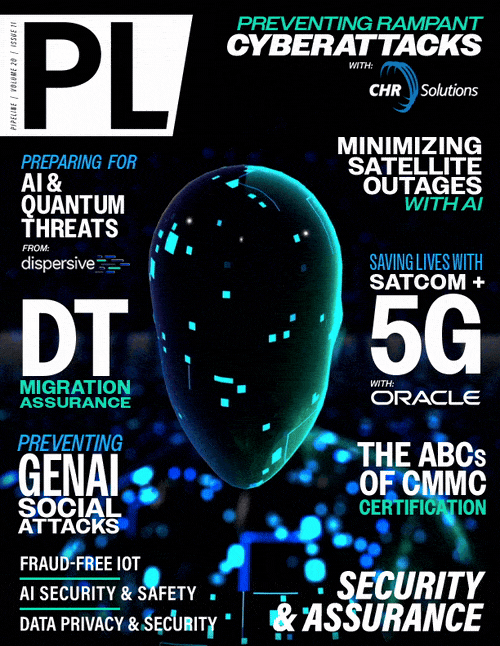Shifting the Balance: Rethinking Cybersecurity
in the Age of AI and Quantum Computing
By: Mark Pohto - CTO, Dispersive Holdings Inc.

The quickly accelerating pace of technological advancement brings both unparalleled opportunities and unprecedented threats. Emerging technologies like generative AI and quantum computing have the potential to revolutionize industries, but they also present grave challenges for cybersecurity. In this digital landscape, where threats evolve faster than many defenses can keep up, traditional passive approaches are no longer enough. Organizations must adopt a proactive, multi-layered defense strategy to address new threats head-on, leveraging cutting-edge innovations like Automated Moving Target Defense (AMTD) and Active Cyber Defense (ACD).
In this article we will explore how the ever-changing landscape of cyber threats requires a comprehensive rethinking of cybersecurity strategies, the crucial role of innovation, and how businesses can better prepare for the future by embracing next-generation technologies and fostering deeper collaboration across the security community.
The Expanding Threat Landscape
Today's cyber adversaries are not just script-kiddies or lone hackers donning hoodies; they are sophisticated, well-funded organizations with significant resources. Nation-state actors, organized crime syndicates, and hacktivists leverage an array of digital tools to exploit vulnerabilities across systems. Nation state actors are well-funded, and their agencies work night and day, 365 days a year against their designated targets. What’s most concerning is that attackers now have and share access to advanced technologies like AI and machine learning, enabling them to scale their efforts and adapt to defensive controls in near real time. The time is quickly approaching when cryptographic algorithms, foundational to much of our security, may be defeated by quantum computing capabilities. The countdown to this moment demands immediate action from cybersecurity professionals.
Passive security models that focus on detection are no longer sufficient. If we want to stay ahead of threat actors, we need to focus on preemptive actions — anticipating, detecting, and neutralizing threats before they materialize. We need an approach as sophisticated and nimble as our adversaries.
The Rising Sophistication of Attacks
The breadth of attack vectors has grown dramatically. Today’s adversaries exploit everything from operational technology (OT) to IoT devices, supply chain vulnerabilities, and human behavior. As the attack surface expands, so does the range of consequences, from business disruption to financial loss, reputational damage, and even threats to human life. Gartner predicts that by 2025, cyber attackers will have weaponized OT environments to successfully harm or kill humans. This stark projection highlights the evolving nature of cyber threats and underscores the need for more advanced defensive measures.
Moreover, malevolent actors are increasingly capable of using AI for automation and efficiency, deploying AI-driven phishing campaigns, creating deepfakes, and even conducting AI-powered reconnaissance on potential targets. These developments can render traditional controls and detections ineffective. To counter such sophisticated tactics, security professionals must elevate their game by incorporating cutting-edge solutions like AMTD and ACD.
Advanced Defensive Technologies: AMTD and ACD
AMTD is an innovative approach that continually shifts the attack surface, making it harder for attackers to conduct effective and undetected reconnaissance, or plan and launch a successful attack. This strategy prevents adversaries from getting a beachhead in the network by regularly changing configurations, parameters, protocols, or resources within the system. Deception is an important part of AMTD. Deception lures the attacker into actions that expose them and their methods. Think of it as a moving target that’s incredibly difficult to hit surrounded by benign targets that expose the attacker and inform the defenders. With AMTD, the focus is no longer on simply detecting and responding to a breach but on preventing attackers from gaining any meaningful access in the first place.
Active Cyber Defense (ACD) goes a step further by integrating offensive tactics into defensive frameworks. Instead of passively defending against attacks, ACD allows organizations to engage with adversaries proactively. This approach might include intelligence gathering, conducting counter-reconnaissance, or deploying deceptive systems designed to trap and mislead attackers. By creating a dynamic and hostile environment for attackers, ACD tilts the balance of power towards the defender. These technologies represent a fundamental shift in cybersecurity, with less passive, static defense mechanisms to agile, adaptive strategies capable of defeating attackers at their points of entry.
Quantum Computing: An Imminent Challenge
Quantum computing delivers extraordinary processing power, but it also threatens to help defeat the cryptographic algorithms that secure today’s data. With quantum computing comes the risk that attackers will decrypt previously secure communications



















